Chris is a gardening writer and nature enthusiast. He graduated from Oxford Brookes University in 2022 with an MA in Psychology. Chris works with the Leeds Green Action Society, helping their food cooperative by growing various fruit and vegetables on their two allotments in Hyde Park, Leeds.
Reviewed By COLIN SKELLY

Colin is a Horticulturist and Horticultural Consultant with experience in a range of practical and managerial roles across heritage, commercial and public horticulture. He holds the Royal Horticultural Society’s Master of Horticulture award and has a particular interest in horticultural ecology and naturalistic planting for habitat and climate resilience.
Contributions From JOE HARRISON

Joe Harrison is a Garden Writer & Content Creator who is also known as 'Grow With Joe' across his social platforms. Joe is best known for his focus on edible gardening in his allotment and the tips he shares to help involve more children in horticulture. He is also the co-founder of the online community The Tomato Club.

Val Bourne is a GMG award-winning gardener, lecturer and author who is known for her organic gardening style - with experience dating back over 60 years. She has an allotment and has published several books on natural gardening, including 'The Ten-Minute Gardener' and 'Colour In The Garden'.

The Bearded Growers are the dynamic gardening duo JJ and Chris, who met at school before reconnecting over a shared love of horticulture. They host their own gardening radio show every week on Cotswolds radio, which has featured guests such as Alan Titchmarsh and Adam Frost.

Shannon Keary is a garden blogger who has her own podcast, The Diary of a Lady Gardener, about her experiences with growing in her allotment. She is currently one of the founders of the Mini Gardeners Club, an association aimed at encouraging young children to take up horticulture. Shannon also runs her own small-scale cut flower farm in Devon.

Janice Shipp is a Writer with 15 years' experience as Principal Researcher for Which? Gardening magazine. She has received her RHS MHort and City and Guilds Planting Design qualifications and is a member of the RHS Herbaceous Plant Committee. Janice is also a member of both the Garden Media Guild and Chartered Institute of Horticulture - and was Chair of forum on a Penstemon trial for the Royal Horticultural Society.

Molly Hollman has received numerous accolades for her garden & plant photography, including winning the Portfolio category of the Garden Photographer of the Year in 2022 and becoming a finalist in the International Close-Up Photographer of the Year in the same year. Molly is also the author of Creative Flower and Plant Photography and writes for the magazine Amateur Photographer on a regular basis.
IN THIS GUIDE
- What Is An Allotment?
- How To Get An Allotment
- Know What You’re Allowed To Do
- How To Start Your Allotment
- 1) Make A Plan
- 2) Be Realistic
- 3) Organic Or Non-Organic?
- 4) Make A Map
- 5) Clear Your Allotment
- 6) Clear The Weeds!
- 7) Prepare The Soil
- 8) Plant Something!
- 9) Crop Rotation
- Maintaining Your Allotment
- What Time Of Year Should You Start An Allotment?
- And There It Is…
- References
Picture this: it’s a lovely summer’s evening, and you’re sat with a cup of tea in the shade of an apple tree.
You’re looking out onto several rows of plump, juicy vegetables, all of which you planted yourself.
A sweet smell fills the air, and the sound of traffic is so distant as to be barely noticeable.
Sounds idyllic, right?
With an allotment, this vision can be made into a reality.
In this guide, we’ll tell you everything you need to start an allotment, from the application process right through to your first harvest.
What Is An Allotment?

Technically speaking, an allotment is just a plot of land made available for non-commercial gardening by your local authority.
According to the National Allotment Society though, “allotmenteering is a way of life – not a plot of land.”
And we’re inclined to agree.
“We are really lucky to have a large allotment which means we can grow a fabulous variety of fruits and vegetables,” shares Joe Harrison, known online as ‘Grow With Joe’.
“This allows us to grow lots of different things throughout the year.”
Your allotment is an opportunity to create an oasis of calm away from the stresses of modern life, metaphorically and literally.

It’s a space where you can shed the hustle and bustle and go back to your roots; where you can see the fruits of your labour bloom in real-time.
“I have an allotment in the Cotswolds which is used to grow my own food, as I am trying to live as sustainable and organic as I can,” shares Chris from The Bearded Growers.
“Getting the kids involved is great as we are teaching them how to grow your own and it also gets them outside in the fresh air.”
His Radio Co-Host JJ also discusses his allotment:
“I’ve had mine for 3 years and it’s been a steep learning curve, but nothing beats growing your own fruit and veg. It’s my happy place and my escape from the real world.
“Much like Chris, I grow organic and sustainably. If the feed is not natural and if it’s full of chemicals you can’t pronounce, then it’s coming nowhere near my allotment.”
How To Get An Allotment
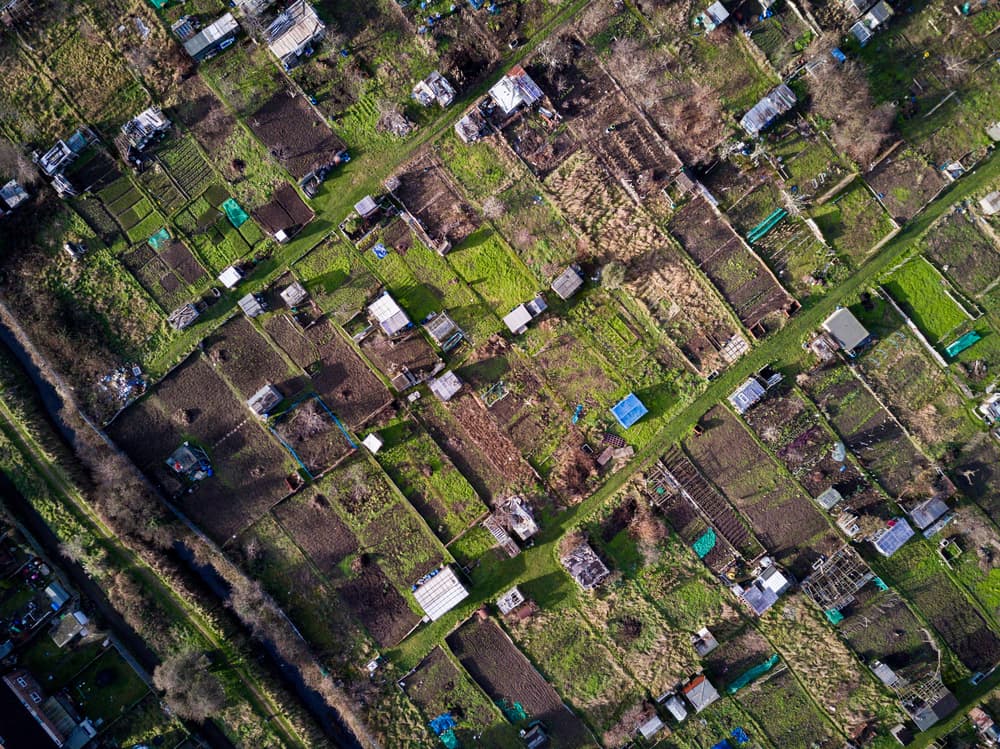
The first step is to get in touch with your local authority.
The Gov.uk website has a page that will point you in the right direction.1Government Digital Service. (2012, May 2). Apply for an allotment. GOV.UK. Retrieved March 24, 2023, from https://www.gov.uk/apply-allotment
In rare cases you’ll get an allotment straight away, however most of the time you’ll be added to a waiting list.
In some boroughs, these are notoriously long (and only seem to be getting longer!) so prepare yourself for a long wait.
The application process and the subsequent waiting period can sometimes be tougher than actually starting the allotment!
Know What You’re Allowed To Do
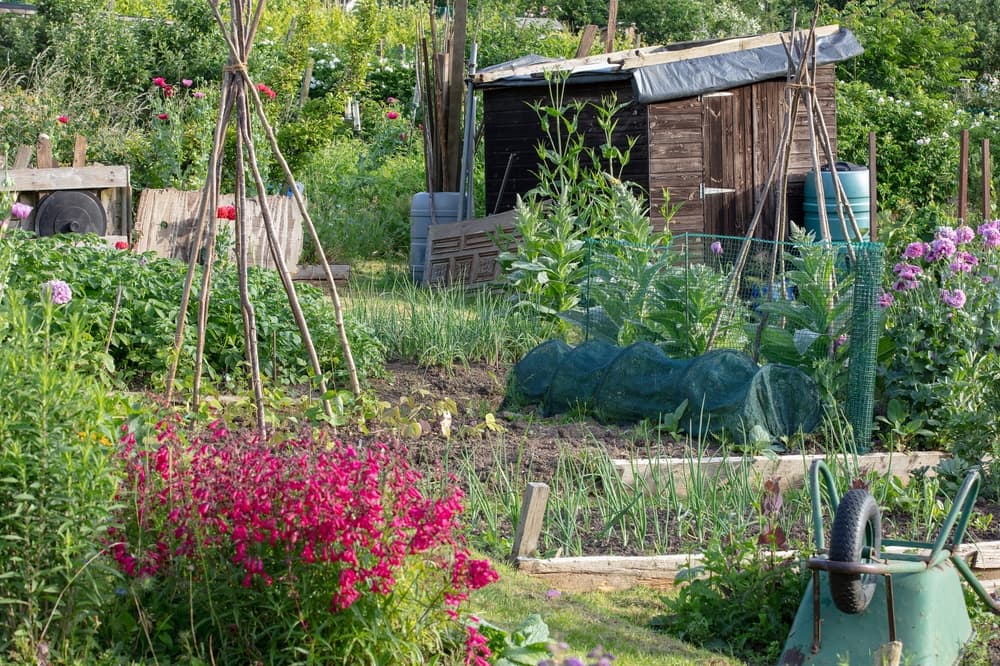
Allotments are covered by their own laws, and as such, allotments come with legally defined restrictions.2Allotments law and community growing. (n.d.). Department for Communities and Local Governments. Retrieved March 24, 2023, from https://www.farmgarden.org.uk/system/files/allotlawandcommgrowing.pdf
Ownership of an allotment comes with expectations and requirements, and failing to meet these can result in losing your plot.3Allotments Management. (n.d.). National Society of Allotment and Leisure Gardeners Ltd. Retrieved March 24, 2023, from https://www.nsalg.org.uk/allotment-info/allotments-management/
The exact wording of your terms and conditions will vary between councils, but the core themes are as follows:
- Keeping the allotment weed-free and in good condition.
- Not using the allotment for any business activities.
- Not causing nuisance or annoyance to other allotment owners, or obstructing paths on and between allotments.
- Not building any structures without written consent.
These rules can feel stifling, especially the one about not building structures, but it’s important to understand that they are designed to make allotment ownership accessible for everyone.
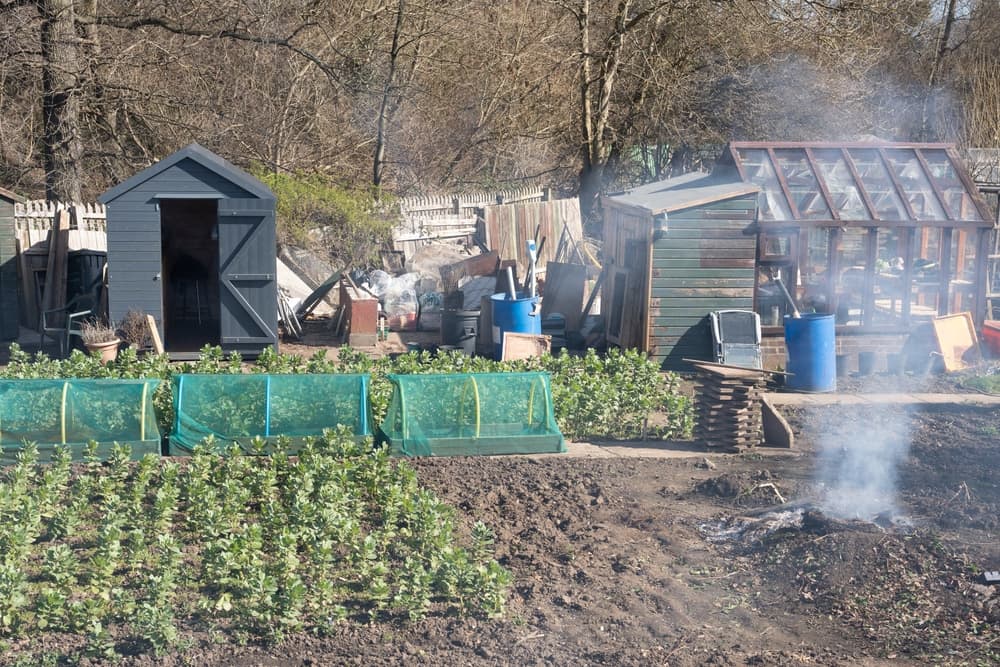
If and when you move on from your allotment, future owners deserve to be greeted with the same blank slate that you were, rather than spending time or money removing buildings.
How To Start Your Allotment

Once you’ve got your allotment, the fun can begin.
Remember that there’s no definitive right or wrong when starting out: it will depend on your skill set, what you want to achieve, the size of the plot, the condition it’s in, and various other factors.
“I have been gardening for about thirty years and am lucky enough to have a medium-sized garden and an allotment,” shares Molly Hollman, Garden Photographer.
“I have a good-sized flower bed and I grow the flowers and plants I love to photograph, especially wildflowers and plants to encourage pollinators.”
The tips in this section are intended to guide you in the right direction.
As you become familiar with your allotment and the work it requires, it’s very likely you’ll deviate from these points and decide how best to structure your time.
1) Make A Plan
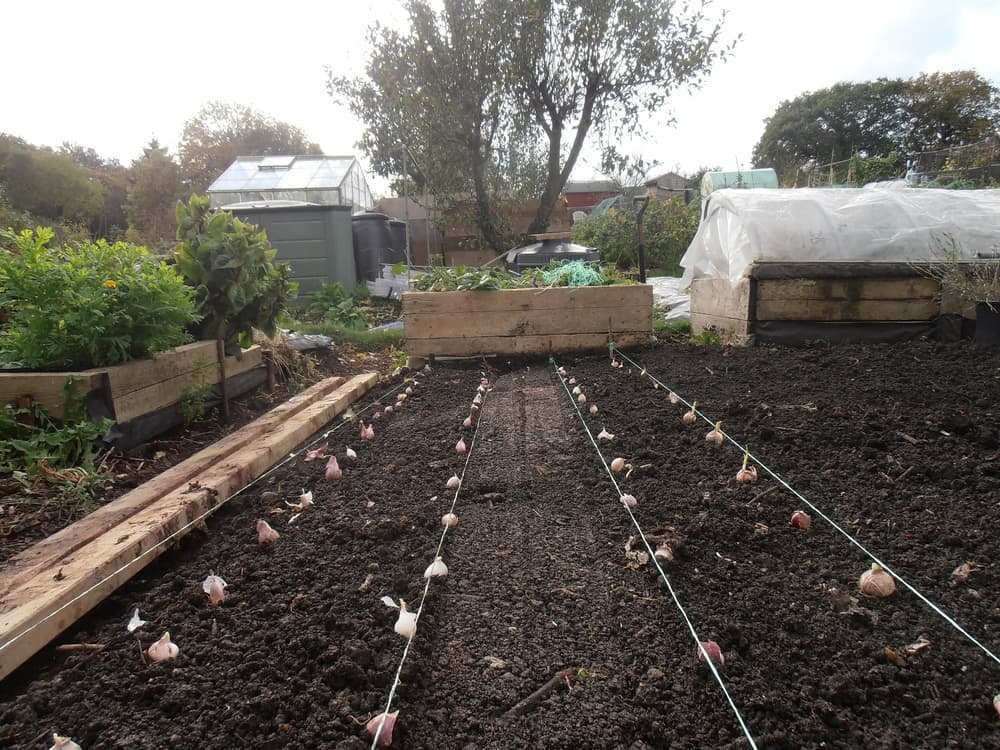
A good first step is to outline what you want to achieve with your allotment:
- Are you going to grow common veggies to save a bit of money on your shopping, or do you fancy growing something a bit more exotic?
- Or maybe you’re only interested in growing fruit?
- And do you want a year-round harvest, or would you rather have minimal involvement over winter?
Ask yourself questions about what you want to grow and when you want to harvest it, then research accordingly.
If you know what you want to grow, write down the times you’ll need to sow and harvest.
If you know when you want to be at your allotment, research plants and seeds that fit your preferred schedule.
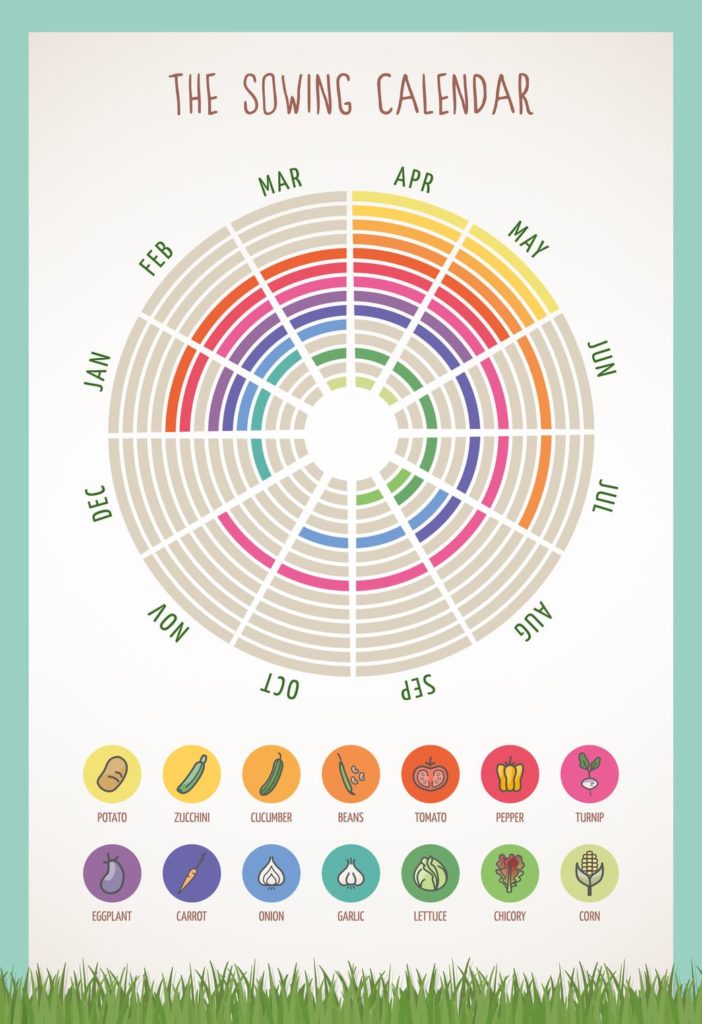
A good plan will provide a structure for you to work towards. It should include:
- What needs to be planted and when.
- What needs to be harvested and when.
- General workdays for things like weeding and clearing.
2) Be Realistic
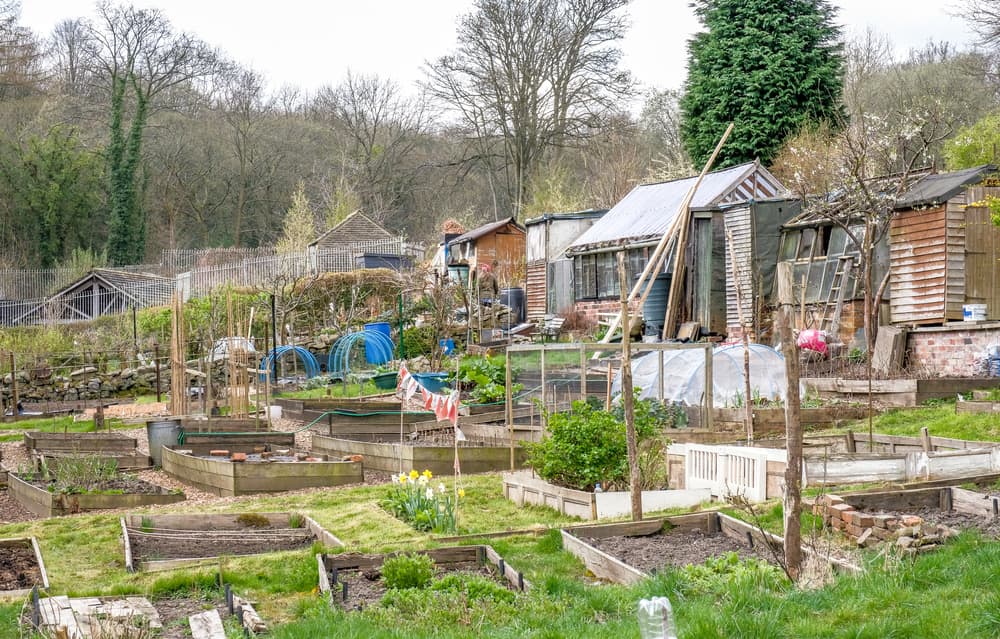
An allotment can feel like a blank slate, ready to be filled with all sorts of wonderful things, but remember that it’s you that has to make them happen!
It’s important to stay realistic with your plans and to not overwhelm yourself, especially in the early stages.
“I am quite selective about what I grow on my allotment because of space,” says Val Bourne, a Garden Writer.
“Luckily, I have a garden too, so I can grow vegetables in that.”
There’s nothing worse than getting demotivated because your wildly ambitious planting plans aren’t coming to fruition.
“Our allotment is roughly the size of a doubles tennis court, and when we took it over, it was an extremely overgrown, unkempt mess which took years to get in order,” shares Joe.
“Once all the weeds, grass, bushes, tree stumps and rubbish was removed we were left with an incredibly large blank canvas to try and manage.
“After a few years, we realised that trying to maintain and plant in such a large area really wasn’t sustainable, so we added some raised beds which really helped.”
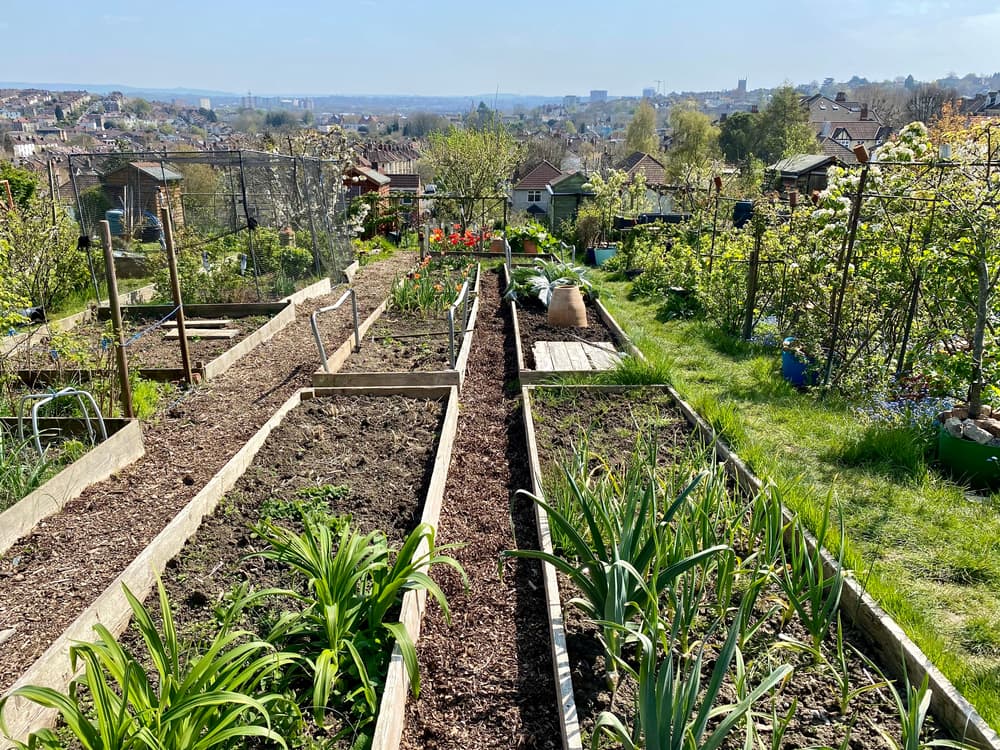
Here’s what to keep in mind:
- How much help can you get? The amount of manpower you can draw on will determine what you can achieve. Some allotments have management teams who can help with initial clearance, for example. And what about friends and family: will you be able to count on their help in exchange for a share of the harvest?
- How much time can you devote to your allotment? Gardening can be hard work. A session of 1-2 hours will feel like a good workout, especially if you do multiple sessions each week. Try to understand how long each task will take, and plan accordingly.
- What condition is your allotment in? If you’ve inherited a plot in poor condition – with weeds and so on – you’ll need to allocate more time to make it more workable. If you did inherit lots of weeds, don’t despair. They’re a sign that the soil in your allotment is fertile: definitely a silver lining!
“The big problem with allotments is that they are full of pests and diseases,” shares Val.
“My allotment is also quite dry and I can’t grow brassicas on it because they just go down with cabbage white butterflies.
“Having an allotment is brilliant, but you might have to limit what you grow there.”
You should expect it to take a year or even more for the whole plot to be usable, so setting expectations early – and giving yourself an honest idea of what you’re up against – can help to tackle despair and frustration later on.
Remember: allotmenting is a way of life and not just a plot of land, and you will notice a return on the time you invest in the early stages.
3) Organic Or Non-Organic?

It’s good to make this decision early on, as certain gardening practices will be out of bounds if you decide to go for organic.
Organic gardeners believe that you should work with a garden rather than trying to exert control over it.
Practices that support and encourage natural processes are used, rather than man-made solutions like pesticides and artificial fertilisers.
If you value things like recycling, renewable energy, reducing pollution, avoiding waste, and similar, then organic gardening could be for you.
“If you are an organic gardener, growing your own produce is very important to you,” shares Val.
“I try to grow as much food as I can an my allotment because I don’t want to have chemicals on our food.”

The benefits:
- Reduces the number of chemicals going into the ground and, by extension, into your crops.
- Effective in managing pests, weeds and disease.
- Effective in maintaining soil nutrients.
And the potential drawbacks:
- Certain tasks may take longer: erecting netting is slower than spraying pesticide, for example.
- There will likely be a bit more damage to your crops.
“I got my allotment about 25 years ago when I first started gardening,” explains Janice Shipp, a Garden Writer.
“I think I just wanted to grow vegetables in a natural way without any chemical sprays and I wanted to eat things when they were really fresh.
“I’m not sure I thought about it being ‘organic’ because I didn’t know much about it then, but I wanted some control over how my food was grown.”
Whatever you decide, bear in mind that owners of nearby allotments may follow organic processes, and may feel compelled to say something if you’re spraying powerful chemical pesticides all over the place.
4) Make A Map

Once you’ve got a plan, and you’ve made the decision of what type of allotment you’ll be growing, you can decide what it will look like.
A physical map of your space is a useful reference point when starting an allotment.
It will help you to visualise what the space will eventually look like, which can be motivating in the early days when you’re faced with an overgrown patch of weeds.
It’s also a great way of making sure the design flows together before you pick up any tools.

To make a map as useful as possible, include beds, paths, and structures.
Marking the rough boundaries of different crops is a good way to keep track of what you’re growing, and to visualise crop rotation patterns (more on this later!).
The more detailed the map, the more useful it will be:
- Where will the compost bin go?
- And the water butts?
- What about an area to sit with a cup of tea and a sandwich after a long session?
Including shade and sunlight areas on the map is helpful when planning which plants will go where.

Drawing a compass bearing on your map can help with this, as can lightly marking the shadows of structures and trees.
Diligence at this stage will pay dividends later.
If you don’t fancy making a map, you should at least have a mental image of what you’re aiming for.
5) Clear Your Allotment

Now comes the physical stuff.
Getting rid of everything you don’t want is a cathartic process, and can often cement the feeling that the allotment is yours rather than borrowed.
It’s an opportunity to look for another silver lining, too: although it’s hard work, you’re preparing a space to be filled only by the things you have chosen.
Rubbish can be removed easily, just take it away in bags to your bins at home, or to a dump.

Unwanted plants can be cut down and either composted or removed.
This takes a little longer. Shrubs and bushes should be cut back to ground level.
Consider borrowing a strimmer if you don’t fancy trimming entire bushes back with secateurs!
Then comes the weeding, which is potentially the longest job. So much so that we’ve dedicated a section to it…
6) Clear The Weeds!

Depending on how severe the weeds are you can either remove them by hand or cover them with sheeting to starve them of sunlight.
“No-dig gardening is increasingly popular because it both avoids the effort of digging and protects soil structure and fungi,” shares Horticulturist Colin Skelly.
“Just start with a thick layer of compost mulch and plant straight into it.
“Charles Dowding is the go-to-market gardener who has done much to promote this growing technique.”
Removing them by hand will involve spending a lot of time on your knees, rummaging around in the dirt.
It’s hard work and slow progress, but seeing a freshly weeded bed is very satisfying.
“When starting your allotment, don’t get overwhelmed,” says Chris.
“A plot full of weeds is a daunting task. Break it down into smaller chunks and when you have weeded and turned over a small area, make sure you plant something.
“Nobody wants to just weed and dig for weeks on end, so seeing something grow can really keep you motivated.”

One thing to remember: don’t throw perennial weeds or weeds that have gone to seed in the compost! They’ll just infest your pile.
If you go for a sheet, you can throw it over the top and forget about it until next year (or at least the end of the next growing season).
The weeds will die slowly as they are starved of sunlight, leaving a nice fresh bed for next season.
Weigh down the corners and sides with stones to prevent the sheet from blowing away when it’s windy.
Also consider a sheet that water can run through: the weeds will take a bit longer to die off, but it’ll be easier to work with wet ground when it’s time to plant things.
7) Prepare The Soil
With all the weeds removed, you can prepare your soil for planting.
Breaking up the soil will make it easier to plant into, and mixing in compost or other organic matter will help to replenish any nutrients that may be missing.
If you’re feeling especially diligent you can do a PH test to find out the condition of the soil. This will give a clearer picture of what nutrients – if any – need to be restored.
8) Plant Something!

Finally, the reason you got an allotment in the first place!
After lots of planning and preparation, you should now have beds of fresh, healthy soil to plant into.
Refer back to your plan to see what needs planting and when.
“At the moment, my allotment is really full of life and I’ve been harvesting garlic, potatoes, peas and beetroots recently,” shares Garden Podcaster Shannon Keary.
“My absolute favourites have to be melons, sweetcorn and pumpkins.”
We really recommend not waiting for the whole plot to be cleared before planting begins: you can plant in each bed as it becomes ready.
This gives you the motivational boost of knowing that things are growing, even though there’s still work to be done.
“I’m growing all my favourites this year – sweetcorn, tomatoes, courgettes, squash, onions, climbing french beans and lots of brassicas, but the slugs have been at those and I’m not sure what will survive,” says Janice.

“Anything is fair game for growing and soft fruits, courgettes, beans and squashes all feature annually in my allotment,” says Chris.
“I grow the same as Chris, but I also like to experiment, so this year I’ve tried growing watermelon with limited success, but growing your own is all about trial and error, so all you can do is try again next year,” JJ adds.
The majority of seed packets have instructions on how and when to plant, so we won’t give instructions for every plant.
What we will say is that it’s important to take heed of these, especially the recommended distances between seeds.
They may seem ridiculously big considering the seed size, but you’ll be surprised how big your crops might grow.
9) Crop Rotation

This is a long-term investment, but having an awareness of the concept is useful when starting out.
As your plants grow, they’ll take certain nutrients from the soil.
Different plants take different nutrients, meaning that the soil can become depleted over time.
(If you did a PH test earlier and noticed any issues, this is one possible reason why.)
Crop rotation is an organic gardening method designed to overcome soil depletion by rotating plants between beds over growing seasons.

The idea is to alternate which nutrient is depleted each year, allowing the others to replenish and for the soil to stay balanced.
The groups usually used in crop rotation are:
- Potatoes.
- Brassicas (cabbage, cauliflower, broccoli).
- Legumes (peas and beans).
- Root vegetables (carrots, parsnips).
You may decide to plant potatoes in a bed one year, then brassicas the next, then legumes, then roots.

In a neighbouring bed you would plant roots first, then potatoes, then brassicas, then legumes.
In the next bed: legumes, roots, potatoes, brassicas. And in the final bed: brassicas, legumes, roots, potatoes.
At the end of four years, each bed will have been used to grow each crop once and – in theory – the soil in all four beds should be full of nutrients.
Maintaining Your Allotment

It’s good to get into the habit of visiting your allotment often.
Even if there’s not a big list of tasks to be done, regular contact with the space helps you keep an eye on things, and nip problems in the bud.
As we mentioned earlier, try to get help from friends and family.
You could organise regular work days where people can drop in and out, offering tea and biscuits in exchange for their hard work.

The rules and regulations often state that you must not let your plot run to seed.
If it becomes too overgrown, or if landlords have any reason to suspect that you are not taking proper care to maintain it, you risk losing ownership.
What Time Of Year Should You Start An Allotment?

Each month brings different considerations in allotment ownership.
Spring is all about planting. Autumn is harvest time. Winter is for maintenance and making sure crops are protected.
If you’re wondering what jobs to do in your allotment in a particular month, we recommend the monthly jobs section of the National Allotment Society website.4Monthly jobs. (n.d.). National Society of Allotment and Leisure Gardeners Ltd. Retrieved March 24, 2023, from https://www.nsalg.org.uk/growing-advice/monthly-advice/
And There It Is…

Allotment ownership is hard work, but it is immensely rewarding.
It’s hard to find an allotment owner who isn’t immensely proud of their space.
The benefits are real.
You get to spend time outdoors, you stay active, you grow delicious food that you can use in your cooking and give to your friends and family.

And there’s nothing more amazing than seeing something come to life that you planted with your own hands.
“Enjoy it once you’ve done the work!” concludes JJ.
“I know that sounds simple, but when you have finished a session on the plot, take 10 minutes to sit and give yourself a pat on the back for a job well done.
“You need to enjoy what you are doing otherwise you will be more inclined to avoid the hard work – and allotments are definitely hard work!”
Hopefully, this guide has gotten you excited about allotment ownership.
There are a lot of practical considerations, but you won’t look back.
Happy allotmenting!
References
- 1Government Digital Service. (2012, May 2). Apply for an allotment. GOV.UK. Retrieved March 24, 2023, from https://www.gov.uk/apply-allotment
- 2Allotments law and community growing. (n.d.). Department for Communities and Local Governments. Retrieved March 24, 2023, from https://www.farmgarden.org.uk/system/files/allotlawandcommgrowing.pdf
- 3Allotments Management. (n.d.). National Society of Allotment and Leisure Gardeners Ltd. Retrieved March 24, 2023, from https://www.nsalg.org.uk/allotment-info/allotments-management/
- 4Monthly jobs. (n.d.). National Society of Allotment and Leisure Gardeners Ltd. Retrieved March 24, 2023, from https://www.nsalg.org.uk/growing-advice/monthly-advice/

